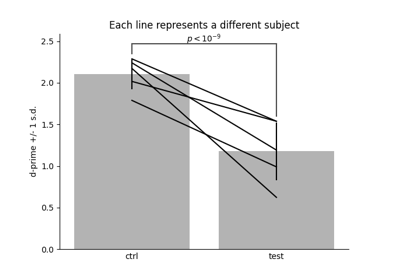expyfun.analyze.dprime#
- expyfun.analyze.dprime(hmfc, zero_correction=True, return_bias=False, two_interval=False)[source]#
Estimate d′ and bias.
- Parameters:
- hmfcarray-like
Hits, misses, false-alarms, and correct-rejections, in that order, as array-like data with last dimension having size 4.
- zero_correctionbool
Whether to add a correction factor of 0.5 to each category to prevent division-by-zero leading to infinite d-prime values.
- return_biasbool
If True, also return the bias.
- two_intervalbool
If True, apply a correction factor for two-interval two-alternative forced choice paradigms (see Notes).
- Returns:
- dparray-like
Array of dprimes with shape
hmfc.shape[:-1].- biasarray-like
Array of bias values with shape
hmfc.shape[:-1]. Only returned ifreturn_bias=True.
Notes
The traditional d′ is given by:
Z(hit_rate) - Z(false_alarm_rate)
And the bias:
-(Z(hit_rate) + Z(false_alarm_rate)) / 2.
where
Zis the inverse of the cumulative distribution function for a standard normal distribution (AKA the percent point function). For two- interval two-alternative forced-choice tasks, Macmillan & Creelman [1] recommend modifying the d′ calculation to account for the presentation of two stimuli per trial (one in each interval) by dividing bysqrt(2):(Z(hit_rate) - Z(false_alarm_rate)) / sqrt(2)
References
[1]Macmillan & Creelman (2005). Detection theory: a user’s guide (2nd ed.). Mahwah, NJ: Lawrence Erlbaum Associates, pp. 166-170.
